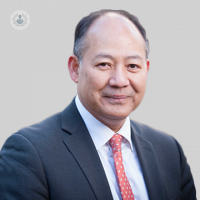Minimal access (keyhole) aortic root surgery: advantages, preparation and recovery
Escrito por:Minimal aortic surgery involves making small incisions in the skin of the sternum to reach the aortic root, which is the section of the aorta that is attached to the heart. The aorta is a large blood vessel that transports blood from your heart to your body. Professor Aung Ye Oo is here to tell us more about this procedure.

Advantages over traditional surgery
Minimal access surgery (keyhole surgery) for aortic root surgery has several advantages.
- It’s a less traumatic procedure for the body compared to open surgery.
- Unlike in open surgery, the lower end of the sternum is stable (and not cut open) during the procedure, which means that patients usually have less pain post-op.
- It also involves less blood loss and therefore requires less blood transfusion.
- Patients can return to activity earlier than patients who undergo open surgery.
- The post-op scar on the chest is much smaller compared to the large scars associated with open surgery.
Preparing for surgery
Consultation
Usually, patients and their surgeons will spend approximately 45 minutes in a consultation. During this meeting, the surgeon will explain the details about the procedure and what happens post-op.
Fasting before surgery
Patients are asked to do the standard surgical preparation e.g. they cannot eat six to eight hours before the procedure. Because of this, aortic root surgery is usually performed in the morning so that the patient can cut off food (fast) from midnight. But there is no special preparation specific to minimal access aortic root surgery.
Anaesthesia
Once the patient has undergone a few checks, they will be given general anaesthesia. This means that they will be asleep throughout the surgery.
The duration of surgery
Minimal access aortic root surgery can take between four to eight hours. The time needed really depends on the extent of surgery needed.
Recovery
Intensive care
After the operation, patients are taken to the intensive care unit (ICU) for recovery. They’ll be in intensive care for two to five days (depending on the extent of the surgery). If for any reason they require organ support, they will spend longer in hospital.
Monitoring
After waking up from surgery, patients generally undergo ECG (electrocardiogram) monitoring for the duration of their stay in the intensive care unit. Then, they move to a standard ward for anywhere between five to 10 days, depending on their age, mobility and the extent of their surgery.
Risks of surgery
Aortic root replacement has a mortality rate of less than two per cent when performed via minimal access surgery. The most intensive form of aortic root replacement (total arch replacement) has a mortality rate of five to seven per cent. Age and general fitness also affect a patient’s risk of death. There’s a risk of stroke with these operations. The risk of stroke is heightened if a patient has previously suffered a stroke or if they have pre-existing conditions.
Precautions during recovery
- Avoid heavy lifting and pushing during the early stages of recovery - the sternum needs time to heal, particularly in the first four weeks after surgery.
- Around the four-week mark, patients can start driving again and return to very light activity.
- Avoid drinking alcohol and smoking, and maintain a normal, healthy diet.
Learn more about Professor Aung Ye Oo’s expertise and how he can help you – visit his profile.


